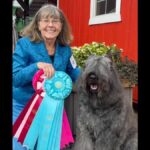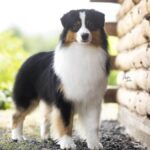Interview with Hound Group Judge Marianne Klinkowski
I received my first Basenji as a gift from my father in 1962 and joined the Basenji Club of America somewhere around 1965. I currently serve the BCOA as Judges Education Chair.
Where do I live? How many years in dogs? How many years as a judge?
Marianne Klinkowski: I live in Cupertino, California, with my husband, Ken, and I am now retired from a career in biotech. I have a daughter, Chrissie, a wildlife biologist, and a son, Kenneth, a tech entrepreneur. I have been in dogs for 60 years and a judge for 25.
What is my original breed? What is/was my kennel name?
Marianne Klinkowski: My father and I brought home our first Basenji in 1962, and I have been a student of this enchanting breed ever since. My kennel name is Naharin.
Can I list a few of the notable dogs I’ve bred? Any performance or parent club titles?
Marianne Klinkowski: My heart dog was Am./Can. Ch Naharin’s Dreamflower, a beautifully moving daughter of my first Basenji; I miss her still. I bred on a very limited basis, but enjoyed showing dogs for friends. Early on, I had wonderful mentors in Jan and Walt Kauzlarich, of Kauzja Samoyeds, who let me tag along to shows with them, and later, my friend Judy Stahl and I attended Conformation classes led by the accomplished Tom Lams. No Performance titles for me, but I did get one leg on a CD in the early 1970s.
What are some of the qualities I most admire in the Hound breeds?
Marianne Klinkowski: Hounds are thinkers and problem-solvers, and can come up with some pretty unique solutions to obstacles that stand in their way. They can be single-minded and determined, and you need to stay one step ahead of them—if you can.
Have I judged any Hound Breed/Group Specialties?
Marianne Klinkowski: I have judged a number of Hound Specialties and one Hound Group show in this country. I have judged Basenji Specialties in Norway, Australia, Canada, and Finland.
Hounds are, first and foremost, hunters. How does this inform my decision-making in the show ring?
Marianne Klinkowski: Yes, Hounds are all about hunting. It comes naturally to them and it thrills them to their very core. Hunting can be very hard, challenging work, and Hounds need minds and bodies that can stand up to years of intense physical exertion. I like to see a Hound move around the ring easily, in full control of its body, well-coordinated, and in a manner appropriate for its breed. Hunting instinct is not judged in the ring, but a Hound with a sound mind in a sound body has, at the very least, a fighting chance to excel in the hunt.
How important are breed hallmarks in the Sighthounds? In the Scenthounds? In the “Primitive” Hounds?
Marianne Klinkowski: Breed hallmarks are vitally important for all purebred dogs, and just as important for Hounds. Most boil down to function, with a few notable exceptions. Let’s take a look at the Basenji. Wrinkles come immediately to mind, but do you know why they are so important? It’s simple and not at all cosmetic. Abundant wrinkles on the forehead of an alert Basenji usually indicate that the skin on the body is sufficiently loose and pliant to serve as protection from the flora and fauna of its native habitat. Recently, a Basenji bitch owned by a friend survived a rattlesnake bite to the head, due in part to immediate veterinary care, but also, I suspect, because her loose skin offered at least some protection from the venomous bite.
Would I have any advice to impart to newer judges of the Hound Breeds who come from other Groups?
Marianne Klinkowski: Many Hounds are sensitive in nature and can be reactive to loud noises and intrusive approaches. They happily work with (not quite for) man and many enjoy the company of pack mates while on the hunt. Some Hound breeds are gregarious and outgoing while other breeds are more introspective and value their independence. All have an innate dignity and sense of self. A newer judge of the Hound breeds should research the history of each breed and study the specific physical requirements needed to excel in the hunt for their ancestral prey. Of equal importance, however, is the necessity to learn and to appreciate the varied temperaments of the Hound breeds, as this makes a world of difference in your approach and evaluation of each distinct breed.
In my opinion, how do today’s exhibits compare with the Hounds of the past?
Marianne Klinkowski: I’ve been around for a while and have seen wonderful examples of all of the Hound breeds, both past and present. I think the use of frozen semen is an immensely valuable resource for us today, and I only wish that it had been available in days gone by to preserve some of the outstanding and underused dogs that we have lost.
When it comes to Group and Best in Show competition, do Hounds have a “leg up” or a liability? (Think Westminster.)
Marianne Klinkowski: This question brings to mind the Westminster finals the year the magnificent Papillon “Kirby” won BIS. It was a very strong lineup, but it seemed to me that the final decision came down to Kirby and the breathtaking Saluki, “Treasure.” Kirby turned it on, using every Papillon trick in the book, eyes sparkling, plumed tail gently waving, ears aflutter. You could almost hear him pleading, “Pick me! Pick me!” All the while, calm and watchful Treasure stood her ground, observing the proceedings with the patience of ages long past. Two vastly different temperaments, but each one absolutely correct for its breed.
If I could share my life with only one Hound Breed, which would it be and why?
Marianne Klinkowski: There are many Hound breeds I would enjoy living with, but if it comes down to one it would be the Basenji.










